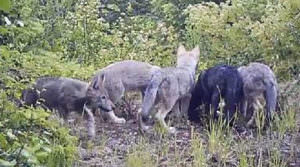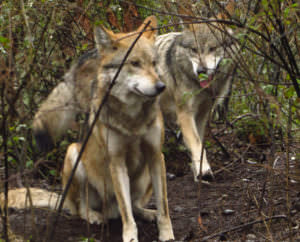
Huckleberry pups
UPDATE ON GRAY WOLF DELIST PROPOSAL!
The comment period has officially been extended to 10/28! Because of the strong public response to this proposal, USFWS will hold three public hearings: DC, Sacramento and Albuquerque. Dates have yet to be determined, so stay tuned. If you live near any of these cities, please consider attending one of the hearings & speaking out for wolves.
Raise your voice for wolves!
You only have until September 11, 2013, to send your comments to the US Fish and Wildlife Service (USFWS) on their proposal to delist gray wolves in the lower US. Your comments are critical – conservation organizations throughout the US are striving to have 1 million comments sent to the USFWS to emphasize the importance of this issue for the continued recovery of wolves in the lower US.
Here are some points to consider including in your comments:
- Delisting gray wolves throughout the lower 48 is premature and contradicts the best available science. The gray wolf has barely begun to recover or is absent from significant portions of its former range where substantial suitable habitat remains. The USFWS draft rule fails to consider extensive suitable habitat in the Pacific Northwest, California, the southern Rocky Mountains and the Northeast. It also fails to consider the importance of these areas to the long-term survival and recovery of wolves, or the importance of wolves to the ecosystems of these regions. The very scientists whose research is referenced in the draft rule to remove the gray wolves’ protections have stated publicly that the science does not support the delisting.
- If delisted, wolves throughout Washington will lose federal protections, which will allow for more lethal control under our current Washington Wolf Conservation and Management Plan.
- Wolves were delisted in 2011 in the northern Rockies, and recreational wolf hunting has significantly reduced wolf populations in those states. Washington’s wolf population largely originated from these adjacent states, and under full federal protection have flourished and expanded. Less wolves dispersing into Washington and the proposed loss of federal protection could greatly reduce the chances for wolves to continue to repopulate areas of Washington that do not have wolves at this time such as Southwest Washington, the North Cascades, and the Olympic Peninsula.
-

These Mexican gray wolf brothers currently reside at Wolf Haven International and are pre-release candidates.
Giving Mexican wolves their own Endangered Species Act listing is long overdue, however, delisting gray wolves throughout the U.S. is counter to protecting Mexican wolves. Fewer than 80 Mexican gray wolves exist in the wild. New populations of these wolves are desperately needed for them to thrive. The best available science confirms that the Grand Canyon region and the Southern Rockies are essential for Mexican wolf recovery. But the proposed rule will leave gray wolves unprotected in these places, making the survival of Mexican gray wolves much more difficult should they expand into new areas.
- A comprehensive recovery plan is needed for Mexican wolf. The current recovery plan was written in 1982 and lacks up to date scientific information. Once a recovery plan is written, any proposed changes should support that plan and should not conflict with recovery needs of the Mexican wolf.
- Allow more Mexican wolves to be released in more places, particularly into suitable habitat outside currently proposed release areas that scientists say is the best habitat and is critical for recovery. At least two more populations of Mexican gray wolves need to be established. Picking up wandering wolves and returning them to the proposed recovery area will inhibit the dispersal of new genes, which is necessary to keep wolves healthy.
WHAT TO DO
Written comments and information concerning each proposed rule can be submitted by one of the following methods to the appropriate docket numbers:
Federal eRulemaking Portal: www.regulations.gov Follow the instructions for submitting comments to the following docket numbers:
Gray wolf: Docket No. [FWS–HQ–ES–2013–0073]
Mexican Wolf: Docket No. [FWS-R2-ES-2013-0056]
Linda Saunders, Director of Conservation
Wolf Haven International



